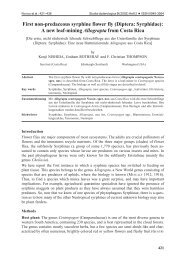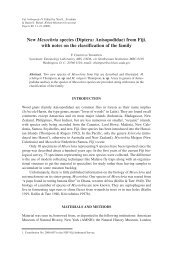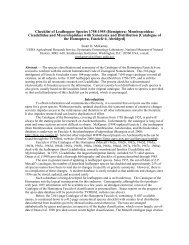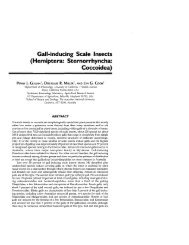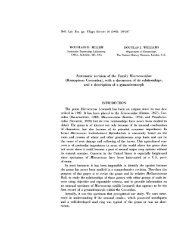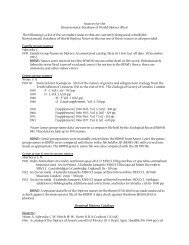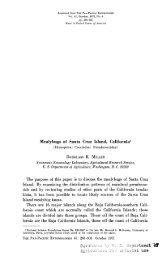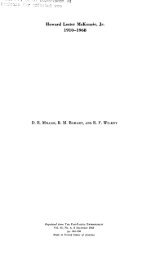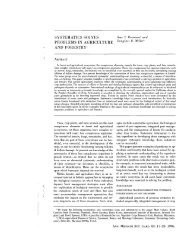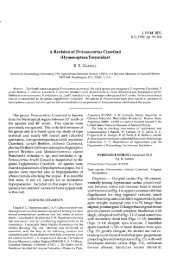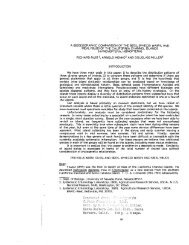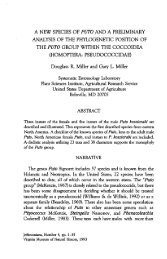Fruit Fly Expert Identification System and Systematic Information
Fruit Fly Expert Identification System and Systematic Information
Fruit Fly Expert Identification System and Systematic Information
Create successful ePaper yourself
Turn your PDF publications into a flip-book with our unique Google optimized e-Paper software.
Norrbom Status of Knowledge 27<br />
FAUNISTICS<br />
Faunal Statistics<br />
We presently recognize 471 valid genera <strong>and</strong> 4,257 valid<br />
species or subspecies of Tephritidae, for an average size of 9.0<br />
species per genus. The size distribution of the genera is distinctly<br />
skewed: 181 genera are monotypic, whereas seven genera<br />
(Anastrepha, Bactrocera, Campiglossa, Dacus, Tephritis,<br />
Trupanea, <strong>and</strong> Urophora) each contain more than 100 species.<br />
The five most economically important genera are also among<br />
the most speciose: Bactrocera (486 species), Dacus (235),<br />
Anastrepha (183), Ceratitis (70), <strong>and</strong> Rhagoletis (62).<br />
Tephritid diversity in the major biogeographic regions is<br />
compared in Table 4. The following summary is based on the<br />
number of native genera <strong>and</strong> species, although the total number<br />
for each region (which includes introduced taxa) is not substantially<br />
different. Based on the described taxa, the Oriental Region<br />
appears to have the greatest fruit fly diversity in both<br />
genera <strong>and</strong> species, although the Afrotropical Region is a close<br />
second <strong>and</strong> may eventually prove to have more genera <strong>and</strong><br />
species. In number of species, following the Oriental <strong>and</strong><br />
Afrotropical Regions, are the Palearctic, Australasian, Neotropical<br />
<strong>and</strong> Nearctic Regions. The diversity of tephritid genera<br />
in these regions is similar, except that the Palearctic Region has<br />
fewer genera than the Australasian Region. The Nearctic fauna<br />
is by far the least diverse, in both genera <strong>and</strong> species, <strong>and</strong> the<br />
Neotropical Region is second least diverse, although it has<br />
almost as many species as the Australasian Region.<br />
The great degree of regional endemism within the Tephritidae<br />
is striking. Most species are restricted to a single region.<br />
Only two species (Tephritis angustipennis & Trypeta flaveola)<br />
are thought to be truely Holarctic (the other 17 species are<br />
introduced, <strong>and</strong> originally not Holarctic), which reflects the<br />
strong decrease in fruit fly diversity with increasing latitude in<br />
the northern Palearctic <strong>and</strong> Nearctic Regions.<br />
Introduced species.<br />
At least 40 species of Tephritidae have been spread intentionally<br />
or accidentally by man beyond their natural ranges. The<br />
figures provided in Table 5 are undoubtedly underestimates;<br />
there are other widespread species that may have been spread<br />
by man, but we included only those for which there is strong<br />
historical or other evidence. The Australasian <strong>and</strong> Nearctic<br />
Regions have the most tephritid species introduced from other<br />
regions, both accidental <strong>and</strong> intentional. The Palearctic <strong>and</strong><br />
Neotropical Regions have been the largest sources of species<br />
introduced to other regions for weed biocontrol, <strong>and</strong> the<br />
Palearctic <strong>and</strong> Oriental Regions have been the largest sources<br />
of species accidentally introduced to other parts of the world.<br />
No species have been intentionally established in other regions<br />
from the Oriental or Australasian Regions. Those regions have<br />
a relatively depauperate fauna of Tephritinae species, which<br />
predominantly breed in Asteraceae <strong>and</strong> have been the focus of<br />
most biocontrol efforts involving fruit flies. No species have<br />
been spread to other regions from the Australasian Region.<br />
Species that have spread beyond their natural ranges or that<br />
have been released in other areas are listed below by genus in<br />
alphabetical order. Refer to White & Elson-Harris (1992) <strong>and</strong><br />
Foote et al. (1993) for references if not stated below.<br />
Acinia picturata, native to North <strong>and</strong> South America, was<br />
introduced for weed biocontrol to Hawaii <strong>and</strong> accidentally to<br />
several other Pacific isl<strong>and</strong>s.<br />
Anastrepha fraterculus, a probable complex of species<br />
native to much of the Neotropics, was introduced but eradicated<br />
in Chile (Enkerlin et al. 1989), <strong>and</strong> also introduced to the<br />
Galapagos Isl<strong>and</strong>s (Harper et al. 1989). A. ludens was believed<br />
by Baker et al. (1944) to be native only to northeastern Mexico,<br />
<strong>and</strong> they considered its presence south to Costa Rica due to<br />
spread by man. An introduction to California was eradicated.<br />
A. obliqua, a widespread neotropical species, was established<br />
in southern Florida (Key West) from 1931-1937 (McAlister<br />
1936), but there is no evidence of a breeding population being<br />
present since then (G.J. Steck, pers. comm.). It has been trapped<br />
in California, but is not established there. It was not introduced<br />
in Bermuda as once reported (Woodley & Hilburn 1994). A.<br />
serpentina <strong>and</strong> A. striata, which also are widespread neotropical<br />
species, have been trapped in California, but are not established<br />
there. A. suspensa, native to the Greater Antilles <strong>and</strong> the<br />
Bahamas, was introduced to Florida in 1965. An earlier introduction<br />
in the 1930’s did not survive (Weems 1965[5044],<br />
1966[5045]).<br />
Bactrocera carambolae, native to the Oriental Region,<br />
was introduced in Surinam prior to 1975 <strong>and</strong> has spread to<br />
French Guiana <strong>and</strong> Guyana (Sauers-Muller 1991, Drew &<br />
Hancock 1994[1238], Food & Agriculture Organization 1994).<br />
B. correcta <strong>and</strong> B. zonata, native to the Oriental Region, have<br />
been trapped in California, but are not established there. B.<br />
cucurbitae, probably native to the Oriental Region, has been<br />
introduced to East Africa, Mauritius, the Ryukyu Isl<strong>and</strong>s of<br />
Japan, New Guinea <strong>and</strong> nearby isl<strong>and</strong>s, Guam <strong>and</strong> Hawaii<br />
(Munro 1984, Hooper & Drew 1989, Kakinohana 1994). Hardy<br />
& Foote (1989) also list northern Australia in its range, but it<br />
does not occur there (Drew 1982[1225], D.L. Hancock, pers.<br />
comm.). It has been eradicated from some isl<strong>and</strong>s of Japan<br />
(Koyama 1989[2773]), <strong>and</strong> has been trapped occassionally in<br />
California, but is not established there. B. dorsalis, also native<br />
to the Oriental Region, has been introduced to Hawaii <strong>and</strong> the<br />
Mariana Isl<strong>and</strong>s. It was eradicated from the Ryukyu Isl<strong>and</strong>s of<br />
Japan (Drew & Hancock 1994[1238]), <strong>and</strong> was introduced, but<br />
eradicated in California. It is not present in Australia as was<br />
once reported (Drew 1976, Drew & Hardy 1981). B. frauenfeldi<br />
has been introduced into northern Australia from New Guinea<br />
(Drew 1976, Hooper & Drew 1989). B. latifrons, native to the<br />
Oriental Region, was introduced into Hawaii (E.J. Harris<br />
1989). B. oleae was considered by Munro (1984) to be native<br />
to Africa <strong>and</strong> spread to the Mediterranean area <strong>and</strong> Canary<br />
Isl<strong>and</strong>s with cultivated olives. It also now occurs in India <strong>and</strong><br />
Pakistan. B. papayae, another native of the Oriental Region,<br />
has recently been introduced to Australia (Allwood 1995). B.<br />
tryoni, native to Australia, has been spread to New Guinea, New<br />
Caledonia, Austral Isl<strong>and</strong>s, <strong>and</strong> Society Isl<strong>and</strong>s. It has been<br />
eradicated from Easter Isl<strong>and</strong> <strong>and</strong> Western Australia (Hooper<br />
& Drew 1989, Fisher 1994), <strong>and</strong> it has been trapped in California,<br />
but is not established there. B. zonata, native to the Oriental<br />
Region, was introduced to Mauritius, although reports that it<br />
occurs on Reunion were based on misidentifications (D.L.<br />
Hancock, pers. comm.).



